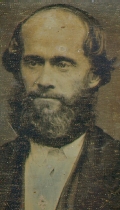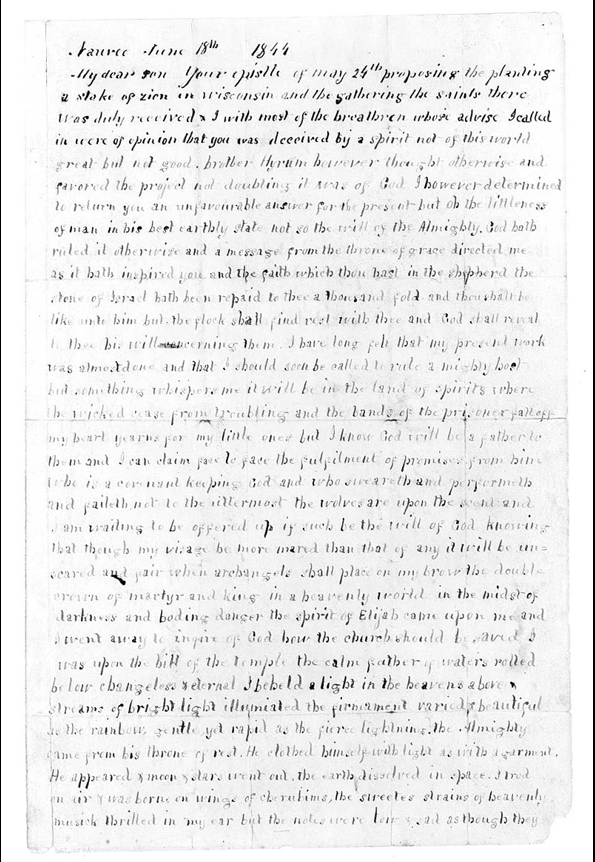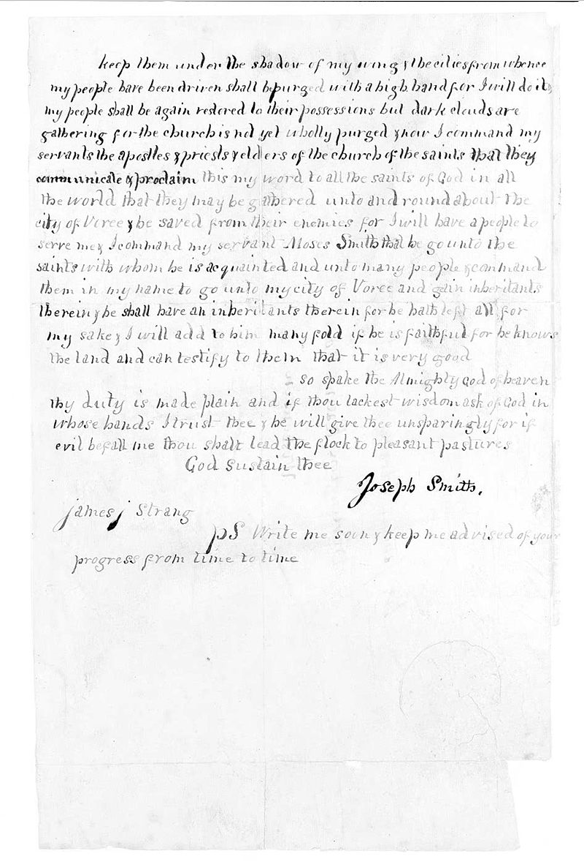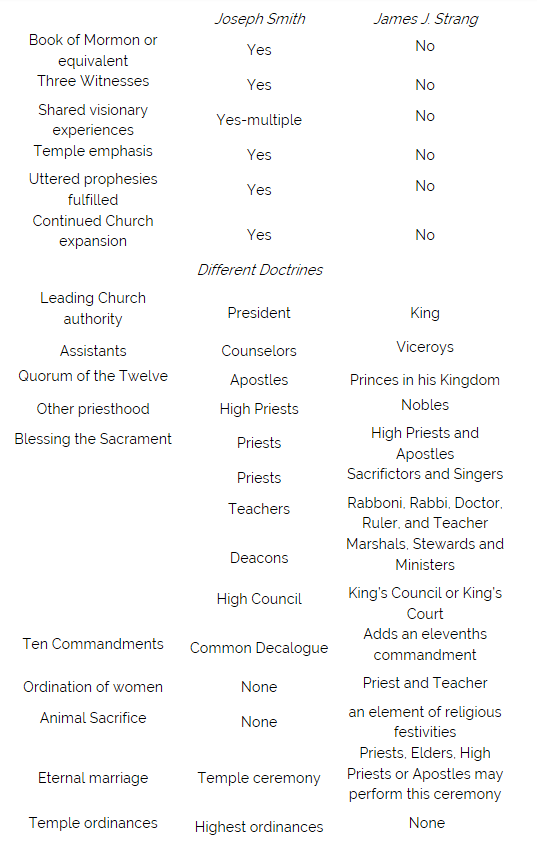
FAIR is a non-profit organization dedicated to providing well-documented answers to criticisms of the doctrine, practice, and history of The Church of Jesus Christ of Latter-day Saints.
SpencerMarsh (talk | contribs) No edit summary |
DavidSmith (talk | contribs) m (DavidSmith moved page Book of Mormon/Witnesses/Strangite parallels to James Strang movement: project to eliminate subpages) |
(No difference)
| |
Summary: James Strang's break-off sect produced eyewitnesses of buried records. Does this indicate that Joseph's ability to do so is neither surprising nor persuasive? The Strangite witnesses were not all faithful, and some recanted and described the nature of the fraud perpetuated by Strang.
Jump to details:

James Jesse Strang was a Latter-day Saint leader in Nauvoo who established a breakaway Mormon sect after the murder of Joseph Smith, Jr.
After Joseph Smith was murdered, there were several claimants to his role as leader and prophet of The Church of Jesus Christ of Latter-day Saints (see Succession in the Presidency of the Church). One of these was James Strang, a recent convert to the church. Several prominent families, including many members of Joseph's family accepted Strang's claims, which were based on a letter which Strang said Joseph had written appointing him as President of the church should Joseph Smith be killed. Along with the letter, Strang claimed that an angel had ordained him to the office of prophet immediately following Joseph's death.
Strang's group is formally called the Church of Jesus Christ of Latter Day Saints (no hyphen, different capitalization) but Strang's church and his followers are commonly called "Strangites."
Strang and his associates settled for several years on Beaver Island in Lake Michigan, where he was pronounced king. Strang, who was an almost pathological overachiever, was also a lawyer, land developer, news correspondent for the New York Tribune, and a scientist for the Smithsonian Institution.
Strang was killed in 1856 by some of his disaffected followers at Beaver Island. Following his death his movement started to disband. Today there are less than 500 Strangite members, living mostly in Michigan and Wisconsin.
Strang's claimed letter of appointment has received a lot of attention from scholars for obvious reasons. There are a few things in dispute about the document. The first is that the wording of the document is somewhat ambiguous. The document seems to only appoint Strang as the president of the newly created Voree Stake in Wisconsin. Strang's son Charles Strang was among those who believed this.[1] Another thing is that the letter is purportedly from Joseph Smith but the document is written in all capitals--uncharacteristic of Joseph's handwriting. Though Joseph Smith likely would have used letter-writing services like scriveners being in a position of leadership in the Church, and outside authorities do not dispute the authenticity of the wording of the document as characteristic of Joseph's education and style.[2] The last thing in dispute of its authenticity is Joseph Smith's signature at the end of it. The difficulty there is that even if the signature were not penned by Joseph, it would not inherently cast doubt on the authenticity of the document since he frequently allowed others to sign for him and it is therefore difficult to know which signature is. The strongest point against the document is therefore its ambiguity.


Many have wondered how James Strang might be different from Joseph Smith. There are several ways in which they differ and it is important to know these differences, for "by their fruits ye shall know them" (Matthew 7:20) and the differences can tell us more about the intentions of each person involved in the succession crisis.

Strang famously claimed that he was ordained by an angel to be successor to Joseph Smith. But the Doctrine and Covenants does not, contrary to Strang's claim, state that one must be ordained by an angel to be a successor.
Strang's claims are dismantled in this article.
It is claimed that break-off sects like James Strang's produced eyewitnesses of buried records, and that because of this, Joseph's ability to produce witnesses is neither surprising nor persuasive.
We should not lose sight of what it was to which the Strangite witnesses bore their testimony. [3] In a manner clearly intended to replicate the Three and the Eight Witnesses to the Book of Mormon, J. J. Strang produced four witnesses who testified that they themselves had dug the Voree Plates from the ground where he said that they would be discovered. Their detailed written testimony was used by Strang in the Voree Herald, January 1846; Zion's Reveille, 1 April 1847; and Gospel Herald, 4 May 1848 and reads as follows:
On the thirteenth day of September, 1845, we, Aaron Smith, Jirah B. Wheelan, James M. Van Nostrand, and Edward Whitcomb, assembled at the call of James J. Strang, who is by us and many others approved as a Prophet and Seer of God. He proceeded to inform us that it had been revealed to him in a vision that an account of an ancient people was buried in a hill south of White River bridge, near the east line of Walworth County; and leading us to an oak tree about one foot in diameter, told us that we would find it enclosed in a case of rude earthen ware under that tree at the depth of about three feet; requested us to dig it up, and charged us to so examine the ground that we should know we were not imposed upon, and that it had not been buried there since the tree grew. The tree was surrounded by a sward of deeply rooted grass, such as is usually found in the openings, and upon the most critical examination we could not discover any indication that it had ever been cut through or disturbed.
We then dug up the tree, and continued to dig to the depth of about three feet, where we found a case of slightly baked clay containing three plates of brass. On one side of one is a landscape view of the south end of Gardner's prairie and the range of hills where they were dug. On another is a man with a crown on his head and a scepter in his hand, above is an eye before an upright line, below the sun and moon surrounded with twelve stars, at the bottom are twelve large stars from three of which pillars arise, and closely interspersed with them are seventy very small stars. The other four sides are very closely covered with what appear to be alphabetic characters, but in a language of which we have no knowledge.
The case was found imbedded in indurated clay so closely fitting it that it broke in taking out, and the earth below the soil was so hard as to be dug with difficulty even with a pickax. Over the case was found a flat stone about one foot wide each way and three inches thick, which appeared to have undergone the action of fire, and fell in pieces after a few minutes exposure to the air. The digging extended in the clay about eighteen inches, there being two kinds of earth of different color and appearance above it.
We examined as we dug all the way with the utmost care, and we say, with utmost confidence, that no part of the earth through which we dug exhibited any sign or indication that it had been moved or disturbed at any time previous. The roots of the tree stuck down on every side very closely, extending below the case, and closely interwoven with roots from other trees. None of them had been broken or cut away. No clay is found in the country like that of which the case is made.
In fine, we found an alphabetic and pictorial record, carefully cased up, buried deep in the earth, covered with a flat stone, with an oak tree one foot in diameter growing over it, with every evidence that the sense can give that it has lain there as long as that tree has been growing. Strang took no part in the digging, but kept entirely away from before the first blow was struck till after the plates were taken out of the case; and the sole inducement to our digging was our faith in his statement as a Prophet of the Lord that a record would thus and there be found.[4]
No one doubts that Strang had a set of a few very small metallic plates in his possession, or that they were removed from the earth in the manner reported above. In that sense, there would be nothing for his witnesses to deny.
Wrote Daniel C. Peterson in "Defending the Faith: The story behind James Strang and his sect," Deseret News (9 June 2011) off-site
The two sets of inscribed plates that Strang claimed to have found in Wisconsin and Michigan beginning in 1845 almost certainly existed. Milo Quaife's early, standard biography of Strang reflects that, while Strang's angelic visitations "may have had only a subjective existence in the brain of the man who reported them, the metallic plates possessed a very material objective reality."
And they were almost certainly forgeries.
The first set, the three "Voree" or "Rajah Manchou" plates, were dug up by four "witnesses" whom Strang had taken to the plates' burial place. Illustrated and inscribed on both sides, the Rajah Manchou plates were roughly 1.5 by 2.75 inches in size — small enough to fit in the palm of a hand or to carry in a pocket.[5]
Ex-strangite Isaac Scott, who was once a leader in the Strangite Church, stated that Caleb P. Barnes told him that he and Strang had actually fabricated the plates. According to Scott, the men,
made the 'plates' out of Ben [Perce]'s old kettle and engraved them with an old saw file, and ... when completed they put acid on them to corrode them and give them an ancient appearance; and that to deposit them under the tree, where they were found, they took a large auger ... which Ben [Perce] owned, put a fork handle on the auger and with it bored a long slanting hole under a tree on 'The Hill of Promise,' as they called it, laying the earth in a trail on a cloth as taken out, then put the 'plates' in, tamping in all the earth again, leaving no trace of their work visible. [6]
Peterson continues:
Among the many who saw them was Stephen Post, who reported that they were brass and, indeed, that they resembled the French brass used in familiar kitchen kettles. "With all the faith & confidence that I could exercise," he wrote, "all that I could realize was that Strang made the plates himself, or at least that it was possible that he made them." One source reports that most of the four witnesses to the Rajah Manchou plates ultimately repudiated their testimonies.
The 18 "Plates of Laban," likewise of brass and each about 7.5 by 9 inches, were first mentioned in 1849 and were seen by seven witnesses in 1851. These witnesses' testimony was published as a preface to "The Book of the Law of the Lord," which Strang said he derived from the "Plates of Laban." (He appears to have begun the "translation" at least as early as April 1849. An 84-page version appeared in 1851; by 1856, it had reached 350 pages.) Strang's witnesses report seeing the plates, but mention nothing miraculous. Nor did Strang supply any additional supporting testimony comparable to that of the Three Witnesses to the Book of Mormon.
One of the witnesses to the "Plates of Laban," Samuel P. Bacon, eventually denied the inspiration of Strang's movement and denounced it as mere "human invention." Another, Samuel Graham, later claimed that he had actually assisted Strang in the creation of the plates.[7]
Chauncy Loomis, in a letter to Joseph Smith III dated 10 Nov. 1888 and published in the Saint's Herald, talked of a conversation that he had with George Adams. Adams described how Strang had asked him to dress in a long white robe and use phosphorous to impersonate an angel. Adams also reported that Samuel Graham talked about how he and Strang fabricated the Plates of Laban. Loomis reported that Samuel Bacon discovered fragments of the plates hidden in the ceiling of Strang's house, and then left the Strangite Church.
At this time George [Adams] was gone from the island on some business. When he returned and saw how things were going he left the island with his family. I saw him and wife after this on Mackinaw Island. He said to me, “Brother Loomis, I always thought you to be an honest man, but you are like poor dog Tray; you have been caught in bad company, and now my advice to you is to leave the island, for I tell you Strang is not a prophet of God. I consider him to be a self-confessed imposter. Strang wanted me to get a couple of bottles of phosphoros and dress myself in a long white robe and appear on the highest summit on the island, called Mount Pisgah, break the bottles, make an illumination and blow a trumpet and disappear so that he might make it appear that an angel had made them a visit; that it might beget faith in the Saint.” I said to him, “Brother Adams, how is it that you deny the testimony given by you so long ago, that you knew Strang was a prophet of God?” “Well, brother Loomis, I will tell you: I was in the spirit of Strang then.” I have since thought that if he ever spoke the truth it was then. I speak of these things that you may see how we were Strang led. I was in the spirit of Strang and foretold some things that would befall us which never came to pass; but I believe that myself and another brother at one time had the Spirit of God, for we prophesied that Strang would be killed, and the Saints would be driven from the island, which truly did come to pass. I shall now make some statement in regard to others who were the chief men of the kingdom. Bro. Samuel Graham, I think, president of the Twelve, declared that he and Strang made those plates that Strang claimed to translate the Book of the Law from. But they in the first place prepared the plates and coated them with beeswax and then formed the letters and cut them in with a pen knife and then exhibited them to the rest of the Twelve. The facts were Graham apostatized and left the island, taking his family and Strang’s first wife, Mary, with him to Voree, Wisconsin. At this time Strang was at Detroit, Michigan. His wife never returned to him; he had four others besides and some concubines. Bro. Samuel Bacon says that in repairing Strang’s house he found hid behind the ceiling the fragments of those plates which Strang made the Book of the Law from. He turned infidel and left the island. [7]

Peterson concludes,
"We can hardly escape the conclusion," writes Quaife, "that Strang knowingly fabricated and planted them for the purpose of duping his credulous followers" and, accordingly, that "Strang's prophetic career was a false and impudent imposture." A more recent biographer, Roger Van Noord, concludes that "based on the evidence, it is probable that Strang — or someone under his direction — manufactured the letter of appointment and the brass plates to support his claim to be a prophet and to sell land at Voree. If this scenario is correct, Strang's advocacy of himself as a prophet was more than suspect, but no psychological delusion."
Thus, Strang's plates were much less numerous than those of the Book of Mormon, his witnesses saw nothing supernatural and his translation required the better part of a decade rather than a little more than two months. (Quite unlike the semi-literate Joseph Smith, Strang was well-read. He had been an editor and lawyer before his involvement with Mormonism.) Perhaps most strikingly, unlike the witnesses to the Book of Mormon, some (at least) of Strang's witnesses later denied their testimonies.
The contrasts work very much in Joseph Smith's favor.[8]
In summary, Strang and his witnesses:
The collective testimony of the Book of Mormon Witnesses is, in terms of its evidentiary value and strength, far more challenging to critics than is the testimony of James J. Strang's witnesses.
It is claimed by one critic of The Church of Jesus Christ of Latter-day Saints that "[e]very single living Book of Mormon witness besides Oliver Cowdery accepted Strang's prophetic claim of being Joseph Smith's successor and joined him and his church. Additionally, every single member of Joseph Smith's family except for Hyrum's widow also endorsed, joined, and sustained James Strang as 'Prophet, Seer, and Revelator.'"[9]
This claim was thoroughly addressed by David Snell—host of the Faith and Beliefs segment of the YouTube channel Saints Unscripted.
To see citations to the critical sources for these claims, [[../CriticalSources|click here]]

FAIR is a non-profit organization dedicated to providing well-documented answers to criticisms of the doctrine, practice, and history of The Church of Jesus Christ of Latter-day Saints.
We are a volunteer organization. We invite you to give back.
Donate Now